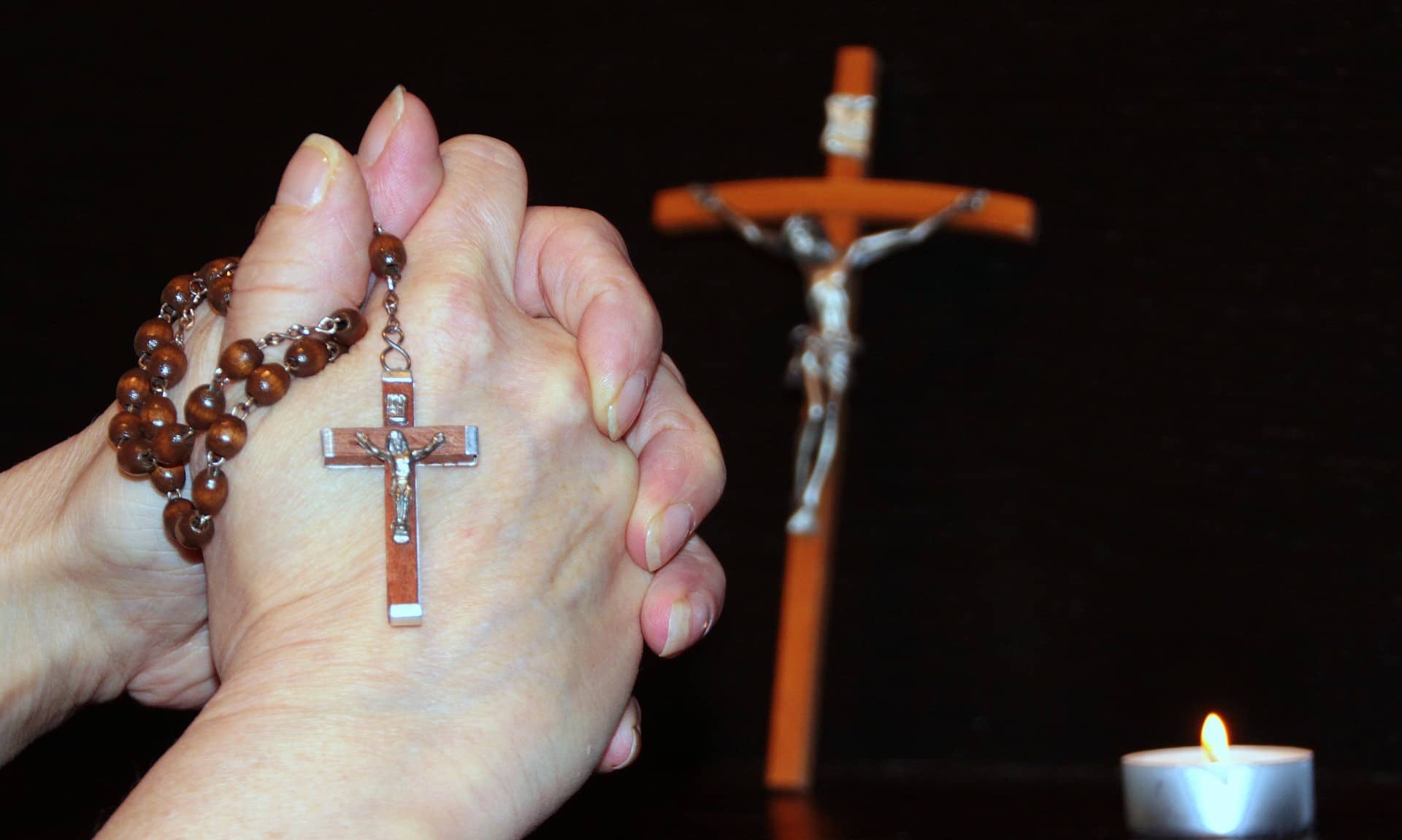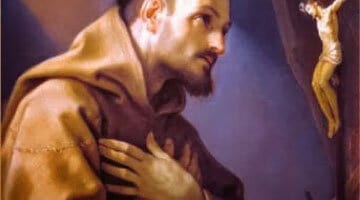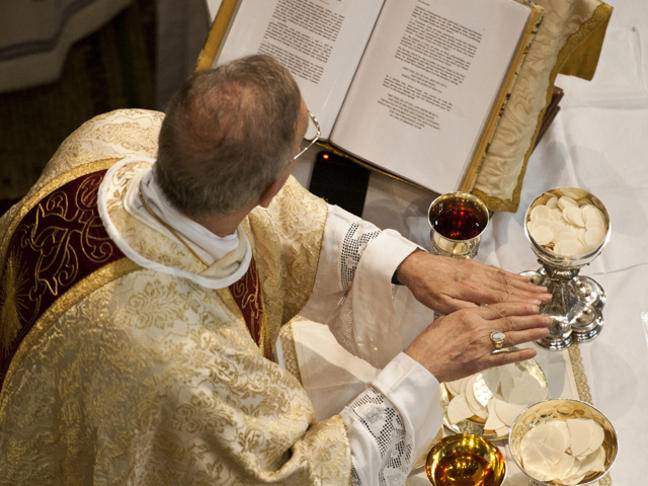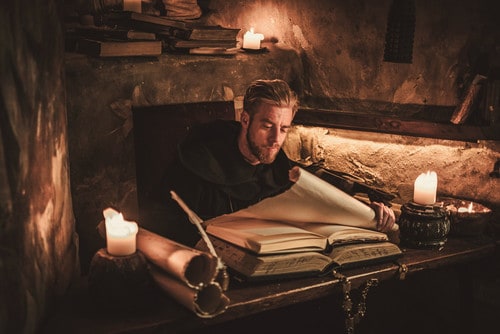
The prayers that eventually became the Rosary date back to before the 11th century. Our Lady gave the Rosary to St. Dominic in the 13th century as a way to combat heresy. Also, Our Lady gave 15 promises to St. Dominic and Bl. Alan de la Roche for those who faithfully recite the Rosary.
The Rosary, a very biblical prayer, takes us through events in the lives of Jesus and Mary and gives us the opportunity to meditate on these events and how they tie in to our lives. Usually the Rosary is prayed using a set of rosary beads, but it is not necessary to use the beads in order to pray the Rosary. Anyone, whether Catholic or not, can pray the Rosary!
Many saints and popes have enthusiastically promoted the rosary as a means to overcome evil and obtain peace in the world. When Our Lady appeared at Fatima, Portugal, in 1917, she asked that people pray the rosary daily.
Pope Pius XI said, “The Rosary is a powerful weapon to put the demons to flight and to keep oneself from sin… If you desire peace in your hearts, in your homes, and in your country, assemble each evening to recite the Rosary. Let not even one day pass without saying it, no matter how burdened you may be with many cares and labors.”
There are so many reasons to pray the Rosary, and so many intentions for which we can offer our Rosary. We can pray the Rosary by ourselves or with others, in church or anywhere—car, plane, doctor’s office, home, outside while on a walk, etc. The important thing is to pray the Rosary!
How to Pray the Rosary
The rosary is a beautiful prayer during which we meditate on events in the lives of Jesus and Mary. Its purpose is to bring us ever closer to Jesus, Our Lord and Savior.
Who Can Pray the Rosary
Anyone who knows six easy prayers can pray the Rosary; you will also need to know the twenty “mysteries” of the Rosary to meditate upon as you pray. You do not have to be Catholic.
The Order of Prayers
The Rosary begins with the Apostles Creed, followed by one Our Father, three Hail Marys (traditionally offered for an increase in faith, hope, and charity), and a Glory Be. Next come five decades, each with a mystery, consisting of one Our Father, ten Hail Marys, one Glory Be, and, if desired, the Fatima Prayer. Conclude with the Hail Holy Queen. After the rosary, you can include prayers for the Pope..
Rosary Beads
If you do not have Rosary beads, it is fine to count with your fingers. Counting beads frees your mind to help you meditate. Try to place yourself into the scene of the particular mystery as you pray and imagine the sights, smells, sounds, and emotions that Jesus, Mary, Joseph, and other participants experienced during the actual events.
The Prayers of the Rosary
- The Apostles’ Creed
- Our Father
- Hail Mary
- Glory Be
- Fatima Prayer
- Hail, Holy Queen
The Twenty Mysteries
The Joyful Mysteries
Traditionally, the Joyful Mysteries are prayed on Mondays and Saturdays and on the Sundays of Advent and Christmas. (But these and all the mysteries can be prayed any day of the week!)
- The Annunciation : The Archangel Gabriel announces to Mary that she will conceive and give birth to the Son of God. Mary says “Yes” to God’s will (Luke 1:26-38).
- The Visitation: Mary visits her cousin Elizabeth, who is pregnant with John the Baptist (Luke 1:39-56).
- The Nativity: Jesus is born (Luke 2:1-21).
- The Presentation: Mary and Joseph present Jesus in the Temple, where they meet the aged Simeon (Luke 2:22-38).
- The Finding in the Temple: After Jesus is lost for three days, Mary and Joseph find the young Jesus teaching the teachers in the Temple (Luke 2:41-52).
The Luminous Mysteries
Traditionally, the Luminous Mysteries are prayed on Thursdays. Pope St. John Paul II introduced these mysteries in his October 2002 encyclical Rosarium Virginis Mariae. (These descriptions are from the encyclical.)
- The Baptism in the Jordan: Here, as Christ descends into the waters, the innocent one who became “sin” for our sake (cf. 2 Cor. 5:21), the heavens open wide and the voice of the Father declares him the beloved Son (cf. Mt. 3:17 and parallels), while the Spirit descends on him to invest him with the mission which he is to carry out.
- The Wedding at Cana: The first of the signs, given at Cana (cf. Jn. 2:1- 12), when Christ changes water into wine and opens the hearts of the disciples to faith, thanks to the intervention of Mary, the first among believers.
- The Proclamation of the Kingdom: The preaching by which Jesus proclaims the coming of the Kingdom of God, calls to conversion (cf. Mk. 1:15), and forgives the sins of all who draw near to him in humble trust (cf. Mk. 2:3-13; Lk. 7:47- 48): the inauguration of that ministry of mercy which he continues to exercise until the end of the world, particularly through the Sacrament of Reconciliation which he has entrusted to his Church (cf. Jn. 20:22-23).
- The Transfiguration: The mystery of light par excellence is the Transfiguration, traditionally believed to have taken place on Mount Tabor. The glory of the Godhead shines forth from the face of Christ as the Father commands the astonished Apostles to ‘listen to him’ (cf. Lk. 9:35 and parallels) and to prepare to experience with him the agony of the Passion, so as to come with him to the joy of the Resurrection and a life transfigured by the Holy Spirit.
- The Institution of the Eucharist: Christ offers his body and blood as food under the signs of bread and wine, and testifies ‘to the end’ his love for humanity (Jn. 13:1), for whose salvation he will offer himself in sacrifice.
The Sorrowful Mysteries
Traditionally, the Sorrowful Mysteries are prayed on Tuesdays and Fridays, and on the Sundays of Lent.
- The Agony in the Garden: Jesus sweats blood while praying the night before His passion (Matthew 26:36-56).
- The Scourging at the Pillar: Pilate has Jesus whipped (Matthew 27:26).
- The Crowning with Thorns: Roman soldiers crown Jesus’ head with thorns (Matthew 27:27-31).
- The Carrying of the Cross: Jesus carries His cross to Calvary where He will be crucified (Matthew 27:32).
- The Crucifixion: Jesus is nailed to the cross and dies for our salvation (Matthew 27:33-56).
The Glorious Mysteries
Traditionally, the Glorious Mysteries are prayed on Wednesdays, as well as Sundays outside of Advent, Christmas, and Lent.
- The Resurrection: Jesus rises from the dead (John 20:1-29).
- The Ascension: Forty days after His resurrection, Jesus bodily ascends into heaven (Luke 24:36-53).
- The Descent of the Holy Spirit: As the Apostles and Our Lady are praying in the Upper Room, the Holy Spirit descends in the form of tongues of fire; and the Apostles go forth and boldly spread the Gospel (Acts 2:1-41).
- The Assumption: Mary is taken bodily—assumed—into heaven by God at the end of her life here on earth (cf. Rev. 12).
- The Coronation: Mary is crowned Queen of Heaven and earth (cf. Rev. 12:1).
Offering Intentions
Practically everyone who prays the Rosary offers the Rosary for an intention. Some people offer particular intentions before each decade. You can ask God to grant you a favor, heal a sick person, or convert a sinner. Some people offer the same intention every day—sometimes for years on end—especially when asking for the conversion of a particular person. Intentions are as varied as the people who pray!Ask for big and small gifts. Be bold! In this sense, the Rosary is an exchange of gifts between friends.
It is widely known that Our Lady answers seemingly impossible intentions for those who are first beginning to pray the Rosary. This is her way of drawing you closer to her Son Jesus. If you are praying your first Rosary or returning to the Rosary after years of not talking to Our Lady, ask for something big, spectacular, “impossible.” She’ll often surprise you!
The Family Rosary
The Family Rosary is usually prayed out loud after dinner or before going to bed. Family members can take turns leading the decades. Some families announce intentions before they begin the Rosary; others take turns announcing special intentions before they begin the Rosary; some take turns announcing special intentions before the beginning of each decade. Many families add favorite prayers at the end of the Rosary, or ask favorite saints to intercede for them.
View Prayer as PDF
Download More Prayers
Submit a Prayer Request



